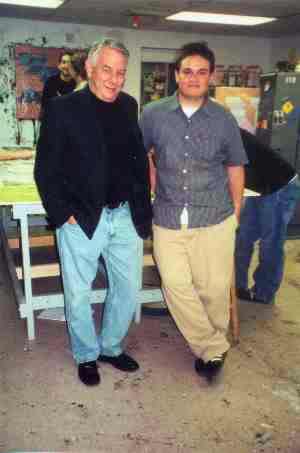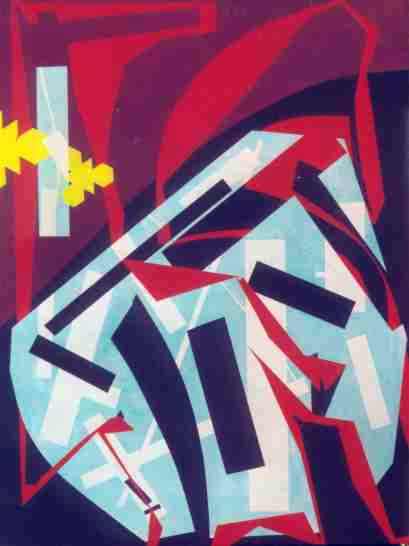Article by Lynda La Rocca
Local Artists – April 2003 – Colorado Central Magazine
WHEN ARTIST MICHAEL CHÁVEZ begins a new painting, he isn’t thinking about the finished product.
In fact, he’s trying not to think about design or hue at all. Instead, Chàvez lets the creative process engulf him. And the result is canvasses filled with evocative shapes and vibrant colors, which create a world of abstractions where form generates meaning based on the viewer’s personal experience.
“I usually don’t do preliminary sketches,” explains Chàvez, who grew up in Leadville. “Sometimes I put a couple of coats of paint on the canvas first; other times, I just start taping and the shapes come out of that.”

Taping? Chàvez uses “masking techniques,” that is, he applies plain, ordinary masking tape to unpainted or previously painted areas of canvas. He then paints either around the tape or within the taped outlines. Sometimes he tapes over already-painted sections, then removes the tape later to apply different colors. This enables Chàvez to retain specific brush strokes and results in a layered painting filled with the “hard-edged shapes” he favors.
Although adept at realistic drawing and painting, Chàvez prefers a much more abstract style. “I can go back and forth [between producing realistic and abstract art], but I don’t because I have a lot more fun with my shapes. Layers, colors, and shapes are what energize me.”
And after working in pencil, charcoal, pastels, and oil paints, and experimenting with sculpture, Chàvez found his niche with acrylic paints, the only medium in which he currently works.
“I like the shiny, ‘plastic-y’ look of acrylics,” he says. “It seems very contemporary to me. Plus, acrylics dry fast and the way I work, I need one layer to dry before I can move on to the next layer.”
Chàvez also mixes his colors in cups, rather than using a palette, which makes it easier to find just the right shade. “I’m often drawn to color combinations that aren’t normally expected to go together” — like bright pink and yellow or mauve and orange — “but I don’t really know why I end up with certain color schemes. They just come out of me.”
A graduate of Leadville’s Lake County High School who earned a bachelor’s degree in fine arts from the Rocky Mountain College of Art & Design in Denver, Chàvez, 22, has been interested in art all his life. But he credits Lake County High School art teacher Nancy Branca with helping him transform that interest into a passion — and a budding career.
“I always liked art, and I always drew a lot as a kid,” says Chàvez, “but she [Branca] really pushed me and showed me what I was capable of.”
WITH BRANCA’S ENCOURAGEMENT, Chàvez entered a self-portrait in a Student Arts Competition at the Cherry Creek Arts Festival and was awarded third prize. One of his colored-pencil drawings also placed first in a Colorado Federal Junior Duck Stamp Conservation and Design Program contest. Sponsored by the U.S. Fish & Wildlife Service and open to K-12 students, this competition chooses first place winners from separate grade divisions. These students then compete for the state award, and the state winner in turn advances to the national competition.
Since high school, Chàvez has shown his paintings at the Rocky Mountain College of Art & Design’s Mu Gallery and at the Timberline Campus of Colorado Mountain College in Leadville. And for the past year, Chàvez has been represented by Ron Judish Fine Arts in Denver, where his paintings command prices ranging from $600 to $2,500.
“Mr. Judish visited [the Rocky Mountain College of Art & Design] and saw my paintings,” Chàvez recalls. “He expressed interest in my work and asked what my goals were. I said, ‘Well, one is to show my work in your gallery.'”
That goal accomplished, Chàvez is now concentrating on another goal, namely, obtaining his K-12 teaching certificate in art through The Metropolitan State College of Denver. He has also applied to graduate schools on both coasts to pursue a master’s degree in fine arts in painting.

WHILE INFLUENCED by visual artists ranging from his college professor and mentor Clark Richert to Picasso and especially Matisse (he’s even named his eight-month-old Welsh corgi puppy Matisse in homage to the French master), Chàvez finds profound inspiration in music. His works often reflect that powerful connection in titles such as “Optical Arpeggio,” “Stringed Accord,” and “Surface Ballad.”
“I always listen to music while I’m painting,” Chàvez explains, “but not one particular style. Sometimes rap, other times country or (Irish singer) Enya. I think music pulls out different brush strokes,” he adds. “I really don’t know how I could paint without it.”
Chàvez, who currently lives in Denver, also draws inspiration from Leadville, which is still home to several childhood friends and a large extended family.
And rather than explaining the “meaning” of his abstract work to viewers, Chàvez prefers discovering what others see in his paintings.
“I like it that people find different images in my paintings. I don’t tell anyone what I see; I want to know what they see. I try not to impose my opinions on people,” he says.

Chàvez points out that three seconds is the average amount of time a person spends looking at a painting. “But I want to bring viewers into my paintings, so that they see something that takes them back to their own experiences or reminds them of something in their lives. I hope that people linger in front of my paintings and draw their own conclusions from my images.
“If someone doesn’t like my work, that attitude is equally valuable,” Chàvez continues, “because it means they at least took the time to look at my work. If they’re thinking, regardless of what they’re thinking, if I bring out a feeling, an emotion, an idea through my painting, then I’ve done my job. That’s when I consider myself a success.”
Lynda La Rocca lives and writes in Twin Lakes when she’s not teaching in Leadville.

